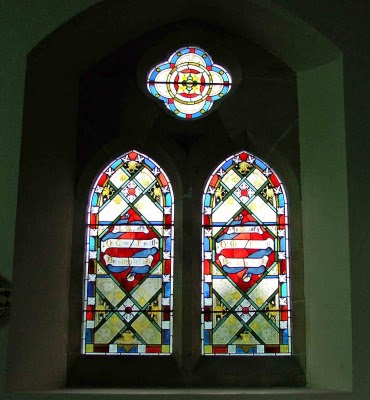Yet more heraldry in Holy Trinity
Kendal
Cumbria
The heraldry theme continues with another set of photos from another recent visit to Holy Trinity in Kendal. First off, the 13th century Strickland chapel, which houses the tomb of Walter Strickland, son of Thomas, aged 9. There will be another entry on the blog about this tomb, so for now, here's the low down on the heraldic symbols on this small tomb. As you can see from the image below, there is a small shield at the bottom right hand side of the tomb, to the right of the date, 1656.

Above. Walter Strickland's tomb in the Strickland chapel.

Above. A close up of the shield on Walter's tomb.
As seen elsewhere on this web site, the Strickland coat of arms consists of a simple trio of shells on a plain background. Apart from the chevrons on the lower parts of the tomb, the date and this shield are the only embellishments on the tomb.

Above. A shield on the side of the un-inscribed tomb in the Strickland Chapel.
The shield on the long side of the tomb in the Strickland Chapel, bears a very precise and excellently rendered shield. It contains the Deincourt arms in the top left and bottom right hand quarters, representing the Deincourt ancestry of Sizergh. The top right and bottom left quarters contain the Strickland arms...the three cockle shells seen elsewhere throughout the church.

Above. A shield on the short side of the un-inscribed tomb in the Strickland Chapel.
The other shield on this strange tomb, represents the Fitzhugh coat of arms

Above. One of the shields on the Parr tomb in the Parr Chapel.
This is one of the three shields on the long side of the tomb, said to belong to Queen Katherine Parr's grandfather, Sir William Parr. The top left and bottom right quarters show the arms of the Ros family of Wark. The top right and bottom left quarters contain the arms of a family I've not yet been able to identify.

Above. Another shield from the long side of the Parr tomb in the Parr Chapel.
This shield shows the Marmion family arms.

Above. Sir William Parr's coat of arms on his tomb in the Parr Chapel.
Sir Williams coat of arms is made up of the following family arms. The top left quarter shows the arms of the Ros of Wark family, and the Parr arms. The bottom left quarter shows the arms of the Marmion family. The top right quarter shows the arms of the Fitzugh family, whilst the bottom right quarter shows the arms of the Ros of Wark family again.
Finally for this post, some of the most beautiful and vibrant glass in the whole of the church. These photos are close up shots of some of the coats of arms to be found in windows throughout the church.

Above. Arms from the first Noble Window in the South wall.
The coat of arms in this window contains elements of the Irton family arms, the three gold rings in the top half of the shield, and the Noble family, represented by the three lions heads in the bottom half of the shield.

Above. Centre pane from the 19th century Yeates window in the South wall.
The top left and bottom right shields contain the arms of the Yeates family (three shields on a yellow and red shield) The top middle shelled shows the family arms of the Bretagh family (a lion over a red grid pattern on a white background) The top right shield shows the arms of the Irton family (a single chevron with three rings over it) The middle bottom shield shows the arms of the Jues family (three gold stars diagonally across a blue band)

Above. The top of the right hand pane of the 19th century Yeates window.
This shield shows the simple Irton family arms. A single chevron with three rings above it.

Above. The top of the middle pane of the 19th century Yeates window.
This shield shows the Yeates family arms. Three gates separated by gold and red chevrons.

Above. The top of the left hand pane of the 19th century Yeates window.
The Bretagh (Bretargh) family arms consisting of a lion a the top of the shield, with cross-crosslets beneath it.

Above. The bottom left of the left hand pane of the 19th century Yeates window.
I've not been able to identify this family arms yet.

Above. The bottom of the middle pane of the 19th century Yeates window.
A shield overlaid by another shield. I'm not sure what this indicates, or who the coats of arms belong to.

Above. The bottom right of the right hand pane of the 19th century Yeates window.
The shield here shows the arms of the Jues family. Three stars on a diagonal band of blue.

Above. The right hand pane of the 19th century Chambre window.
A complicated shield, this incorporates elements of the Charlton family (the lion in the central shield surrounded by the fleur-de-lys) What the other elements of this coat of arms relate to is beyond me at this stage!!

Above. The middle pane of the 19th century Chambre window.
This coat of arms represents the Chambre arms dated from about 1716, and consists of four 'marlets' (birds of some kind) between an ermine cross.

Above. The left pane of the 19th century Chambre window.
This coat of arms depicts the Charlton family arms. Simply showing a 'lion rampant' filling the whole of the shield.
As usual, as more information is obtained about these beautiful renditions of various Westmorland and Cumbrian family coats of arms, it will be posted here.






















































